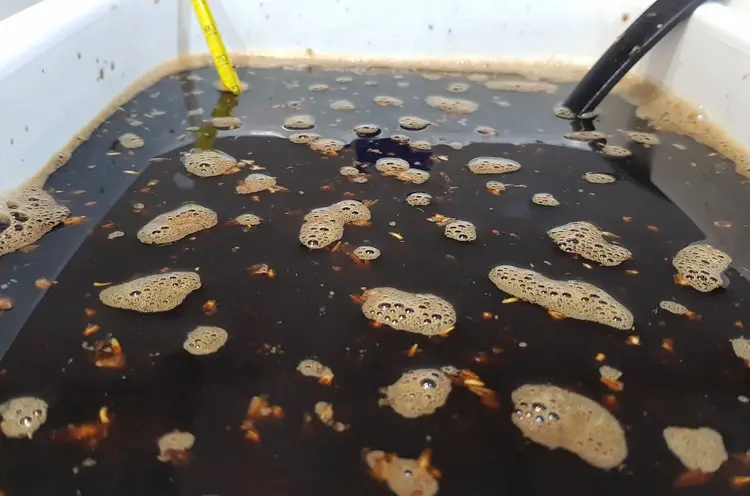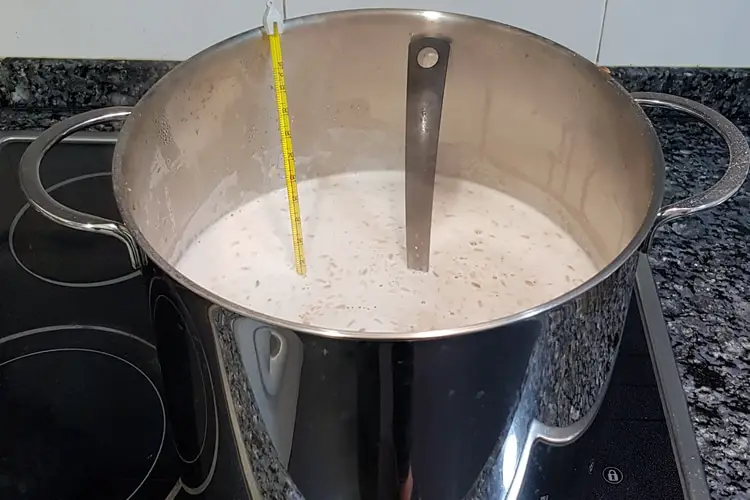Mashing is the number one thing that enters you into the realm of Journeyman brewer, much less Master Brewer. Knowing how to mash properly every time takes years of practice and even then confounds the seasoned veterans. Do we need to mash out at the end of process? Well, it depends.
A mash-out is unnecessary for homebrewers. It is used primarily by commercial brewers who must keep a consistency of process unneeded at home. Mashing out is a benefit as it transitions seamlessly into proper sparging and thorough sugar extraction.
Focus on the mash-in. Mastering this art can keep the brewer busy for many years.
What is a mash out?
A mash-out is when the brewer raises the mash temperature at the end of the mash, say after 90 minutes, to 165 – 170˚ F (73 – 76° C). The ostensible purpose is to raise the mash temperature to stop all enzymatic activity, as well as prepare the beer for immediate sparging which occurs at 169 – 172˚ F (76 – 77° C) at the maximum.
When to mash out?
Start the mash out after you have conversion – a full 90 minutes. I’ll let you in on a little secret. I tested for conversion with iodine exactly twice over 16 years.
Once at home and once at the French broad brewing company.
The mash is done after you have converted all readily accessible starches to sugars.
That is breaking down complex glucose molecules into smaller chains, sweet to the taste and easily fermentable.
Why did I not test?
I tasted it and the mash was sweet and sugary.
Imagine Vanilla Wafers with banana slices inside, watching cartoons on Saturday morning. Grandma used to give me those. The wort was sweet, so it was ready. And, after a time I trusted myself and my thermometers. If I hit the temperature guidelines, conversion complete.
I know we already mashed for 90 minutes as this is optimum for FULL extraction, right?
If you’d like to revisit the benefits of the 90-minute mash please revisit the article, Mashing at Too High of a Temperature, Now What?
It can be complicated to mash out
Most homebrewers, even me at my zenith, mash in a simple unmodified cooler: an excellent insulated container keeping heat as well as cool.
Now, I could dump all the mash back into the kettle, surely to spill 5%, scorch another 5% and make a mess…or take a 10-minute break, burn one, and sit on your porch and enjoy the Spring morning, the yellow-green leaves just starting to bud in the top of the trees.
Up to you!
Scoop into your lauter and get on with it
After the aforementioned break, the sparge water was carefully measured and that is in the kettle heating instead. If you have a false bottom or a lauter-manifold then, Holy Smokes, good on ya!
Do not you dare forget the vorlauf.
This will take at least 20 minutes and yes, it must be done, the pros do it, master homebrewers do it, and so should all.
I don’t like to use should, but in this case, consider it a Golden Rule.
LOTS about the benefits and irredeemable features of vorlaufing may be seen in the article, You Should Recirculate (Vorlauf) Your Mash. Here’s Why.
Can you skip the mash out time just replacing it by sparging since the water temperature is the same?
Yes, you can. I did it each time I sparged largely due to the primitive equipment I had as recounted above.
If you keep your sparge water hot, as in use a cooler or insulated box to hold it, the mash will heat up within 10 – 15 minutes, enzymes killed off, and extraction will be effective.
At French Broad, when I was a professional brewer, I had a steam-jacketed mash-kettle. I would mash there, mash out at 170˚ F (76° C) and transfer over to the lauter. The drawback to the system was that I had to dilute the mash so that it would effectively pump over. The mash also cooked a little, so got a bit mushy.
The sparge water could be 12 – 18” (30 – 45 cm) over the top of the grain bed which made it susceptible to compacted mashes. Also, the water is cooling down while you wait to add fresh sparge water.
Mashing out in a cooler

One method of mashing out in a simple cooler would be to add hot water equivalent to the mash volume, at say 190° F (87° C), which would raise the temperature into the 165˚ F range (75° C), shut down enzymatic action and prepare the mash for proper sparge temperatures.
However, not the most recommended method.
Upon vorlauf, there would still be a high grain-water ratio and the grain bed would settle too much.
There are some brewers who appreciate complex mash procedures, called step-mashing, wherein you hit several different temps over the course of the mash. This is mostly utilized for German beers and lowly-modified 6-row malt.
Technology aids the brewer
Hi-Tech facilitates the techniques to bring profound malt complexity out of the beers.
German lagers have intense nuanced maltiness in part due to these methods.
Without a heated mash-tun, it would be very difficult.
It could be done in a kettle under direct heat, but that runs an extreme risk of scorching the mash and killing off enzymes prematurely.
If you had an incredibly sensitive gas burner, an exceptionally thick, quality stainless or copper kettle, and not least of all Zen-like patience, you could step-mash over fire.
With the quality and variety of highly-modified, high enzyme content 2-row malts, it may not be worth it.
There are now all-in-one mash / sparge / boil set-ups that can broaden the experience and versatility of the brewer.
One to check out is the Grainfather, among others. They can be pricey but enable the brewer to maintain strict control over all processes.
Even so, be careful the mash-out doesn’t turn into barley soup.
No products found.
The Pros and Cons of formally mashing out
As recounted above, yours truly brewed more informally, with instinct as opposed to enzymatic and conversion analysis.
Should mashing out be the path, here are some benefits and drawbacks to consider.
| PROS | CONS |
|
|
Last Runnings on this Mash
The mash-out indicates an advanced brewing position and may be undertaken if the brewer has reached that level. In any situation it is time-consuming and for 5 – 10 gallons of beer, it simply may not matter: if the sparge water temperature is accurate and held in an insulated vessel.
The pros and cons balance out.
The best situation for mashing out is with an evenly heated mash/kettle, wherein the brewer is already utilizing reasonably complex step-mashing techniques. As the system is set up for it, mashing out is a logical step.
I’ve brewed in a number of professional kettles and stood in good, storied company among professional ranks. If their mash-tun or mash-lauter was not heated, they got the sparge water hot, vorlaufed, and sparged away; no mash out required. So it goes.
Even for commercial brewers, work with what you have.
Last update on 2025-03-24 / Affiliate links / Images from Amazon Product Advertising API

